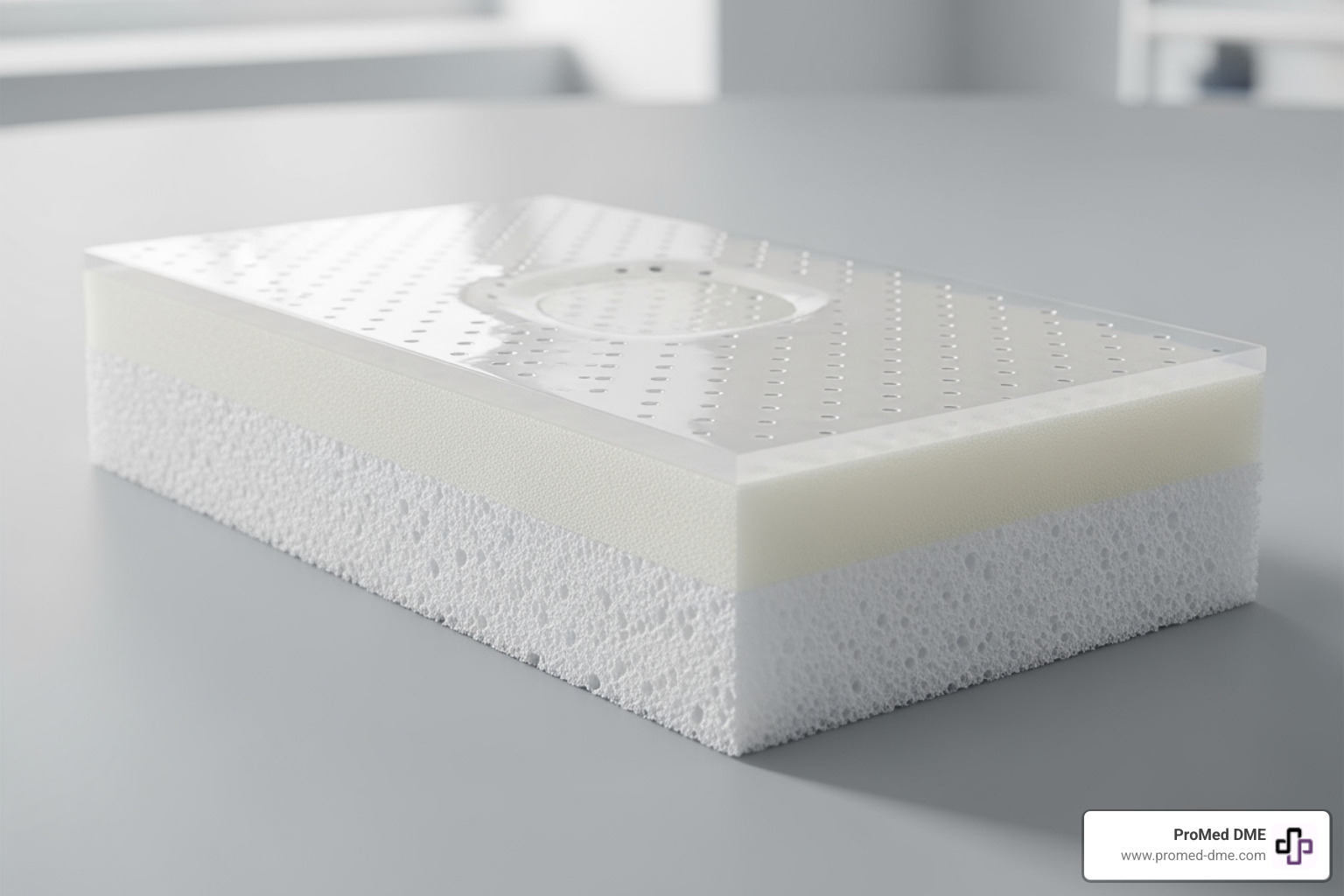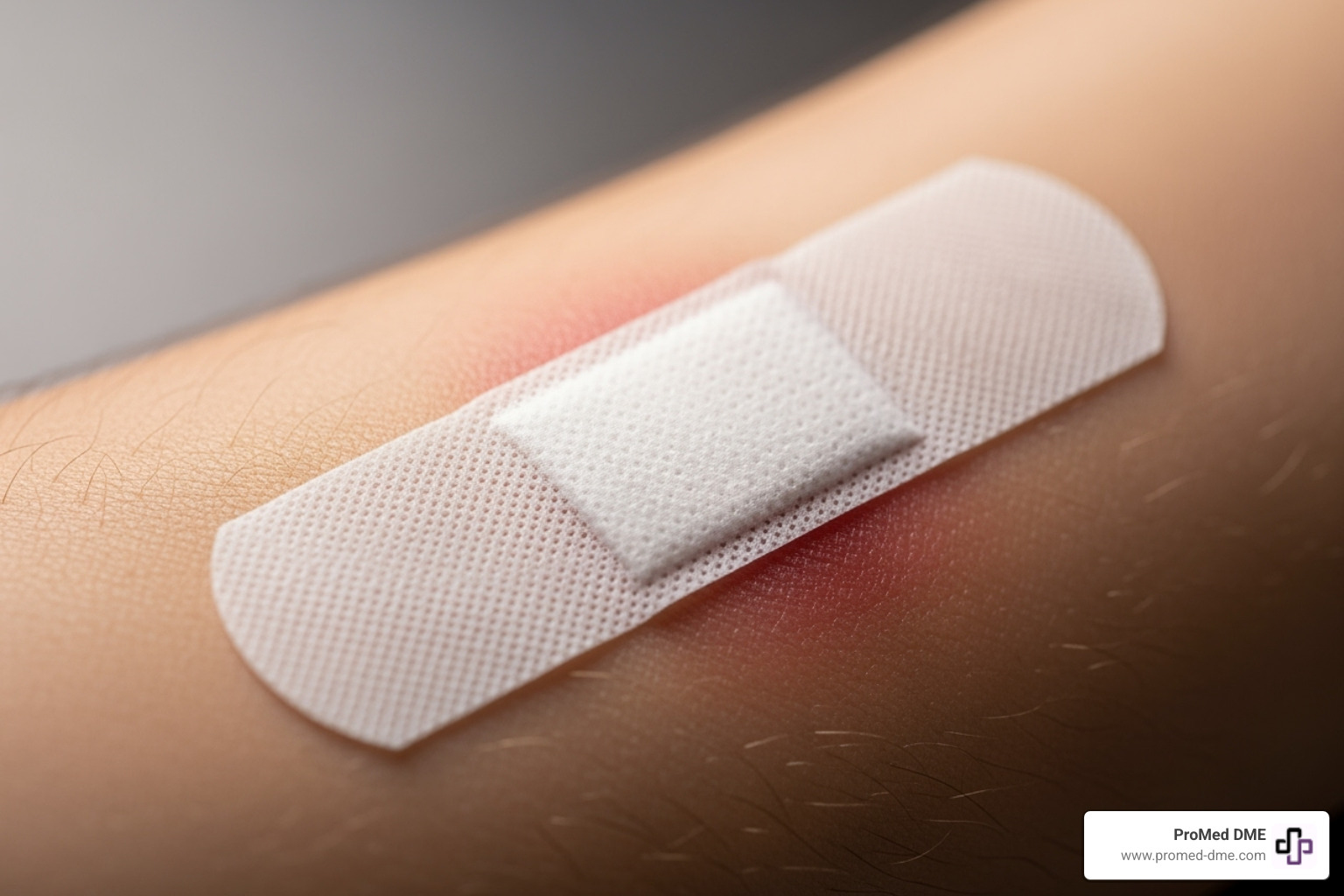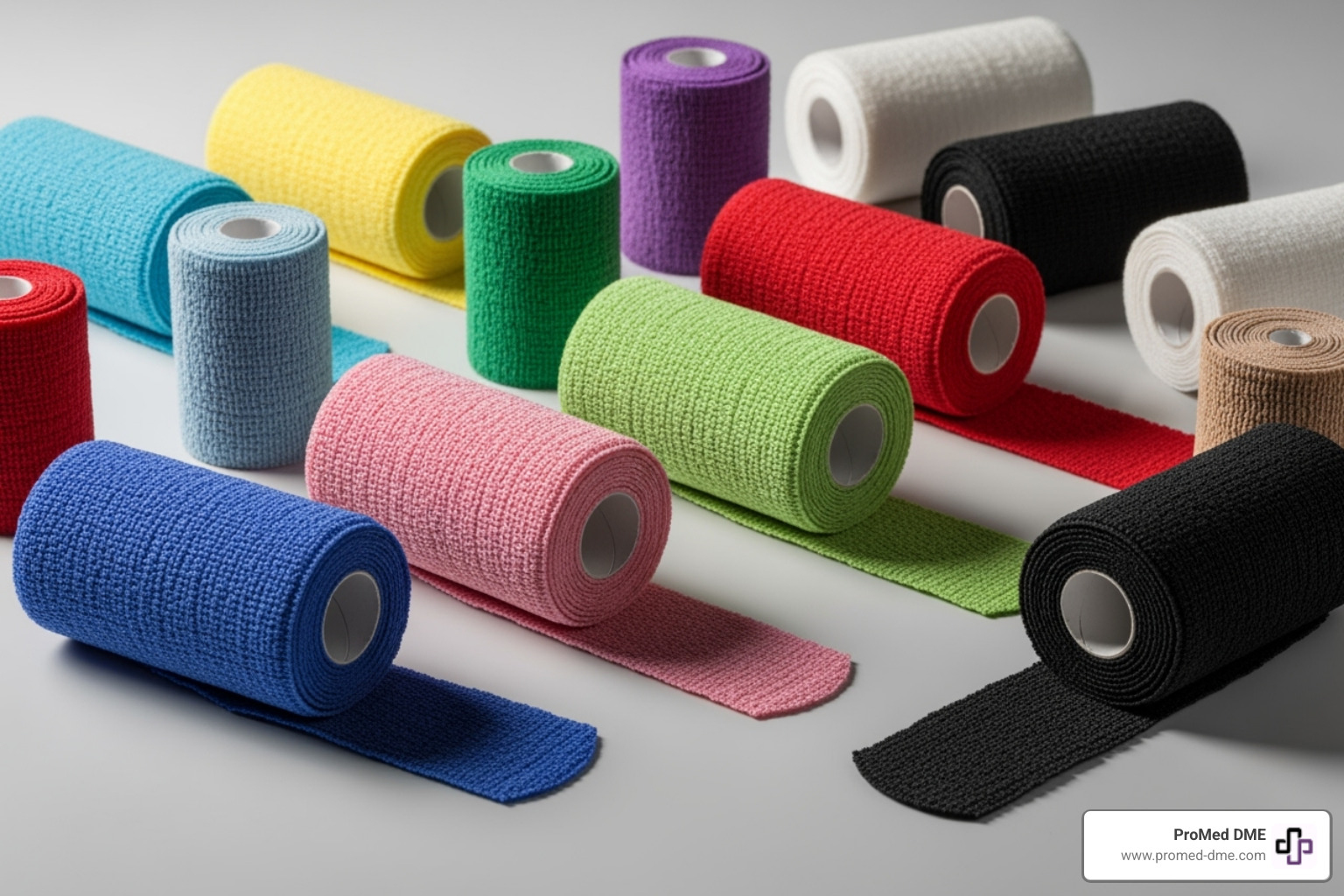Doggy First Aid: A Guide to Cohesive Bandages for Fido
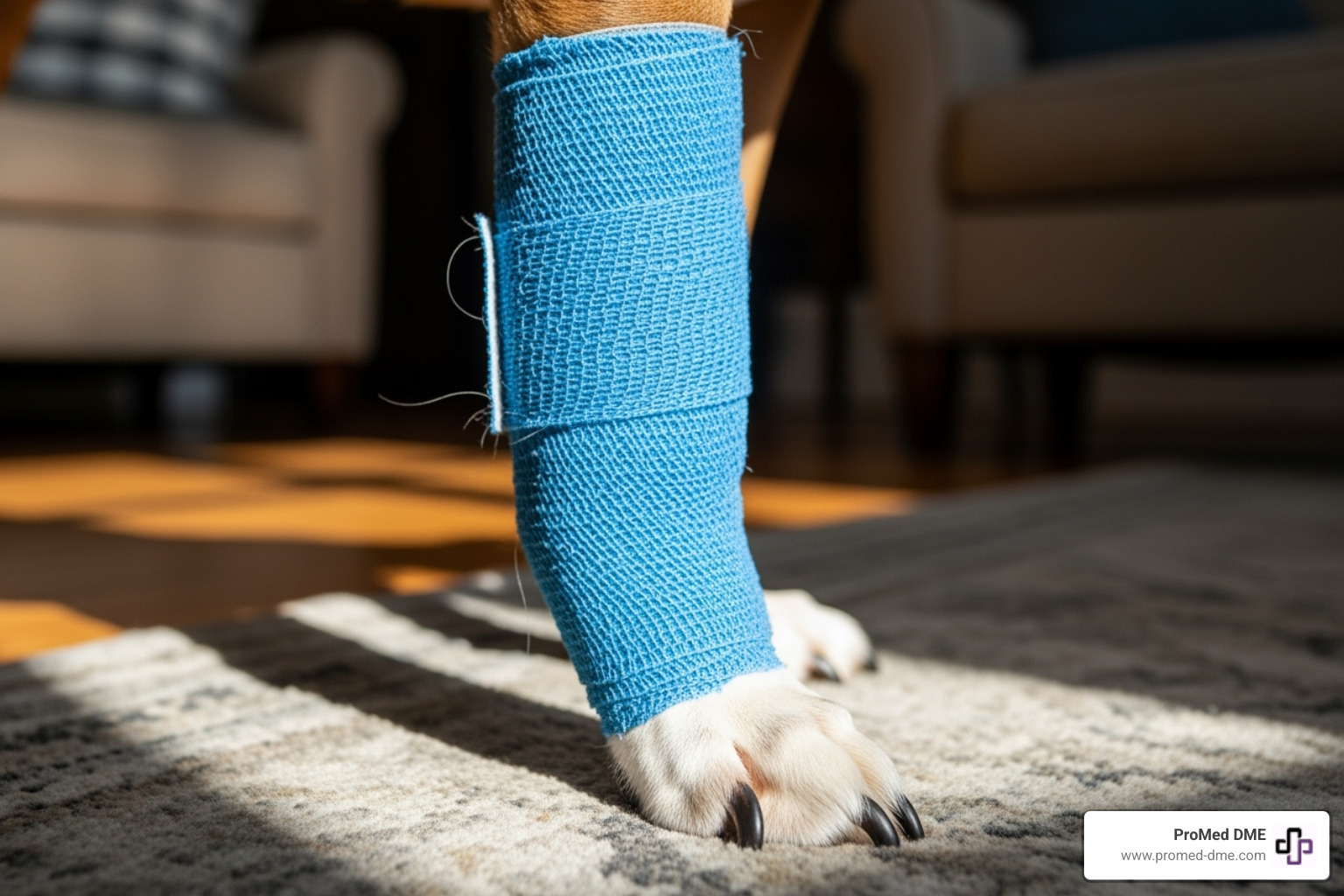
Your Dog's First-Aid Kit Essential: The Cohesive Bandage
A cohesive bandage for dogs is a self-adhering wrap that sticks to itself but not to your pet's fur or skin, making it perfect for wound care and injury support. These specialized bandages eliminate the pain and stress of removal that comes with traditional adhesive tape.
Quick Guide to Cohesive Bandages for Dogs:
- What they are: Self-sticking elastic wraps that only adhere to themselves
- Best for: Minor cuts, sprains, securing dressings, post-surgery protection
- Key benefit: Pain-free removal without pulling fur or skin
- Material: Breathable, porous non-woven fabric
- Sizes: Available in 1", 2", 3", and 4" widths
- Special features: Water-resistant, no clips or pins needed
When your dog gets a cut paw during a hike or needs support for a sprain, cohesive bandages provide the perfect solution. Unlike regular bandages that can stick to fur and cause distress during removal, these wraps create a secure hold without the trauma.
Pet owners find it convenient to keep self-adhesive bandages around the house for strains or sprains their pets may incur. Veterinary practitioners worldwide rely on cohesive bandages because they won't adhere to an animal's skin or fur, allowing for removal or adjustment without causing distress.
The breathable fabric allows air circulation while providing controlled compression that won't constrict. Available in different tensile strengths - from 10 lbs for light support to 23 lbs for maximum stability - these bandages adapt to your dog's specific needs.
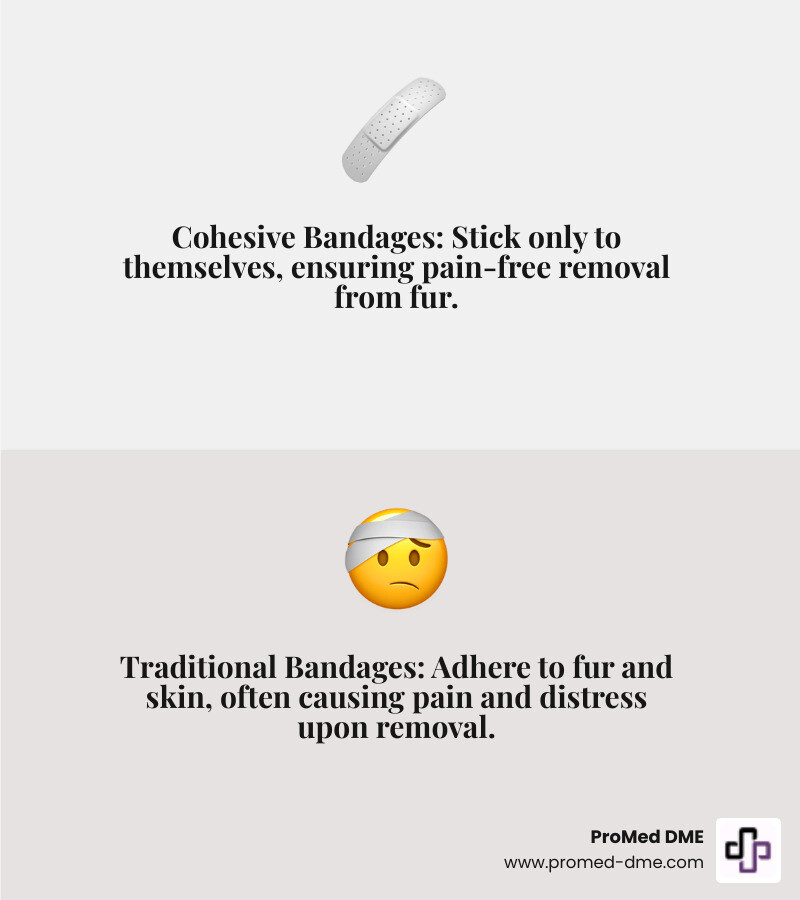
Know your cohesive bandage for dogs terms:
When to Use a Cohesive Bandage (and When to Call the Vet)
Every pet parent has been there—your furry friend comes limping home from their latest adventure, or you notice them favoring one paw after an enthusiastic play session. Having a cohesive bandage for dogs in your first-aid kit can be a real lifesaver for those minor mishaps that seem to happen when you least expect them.
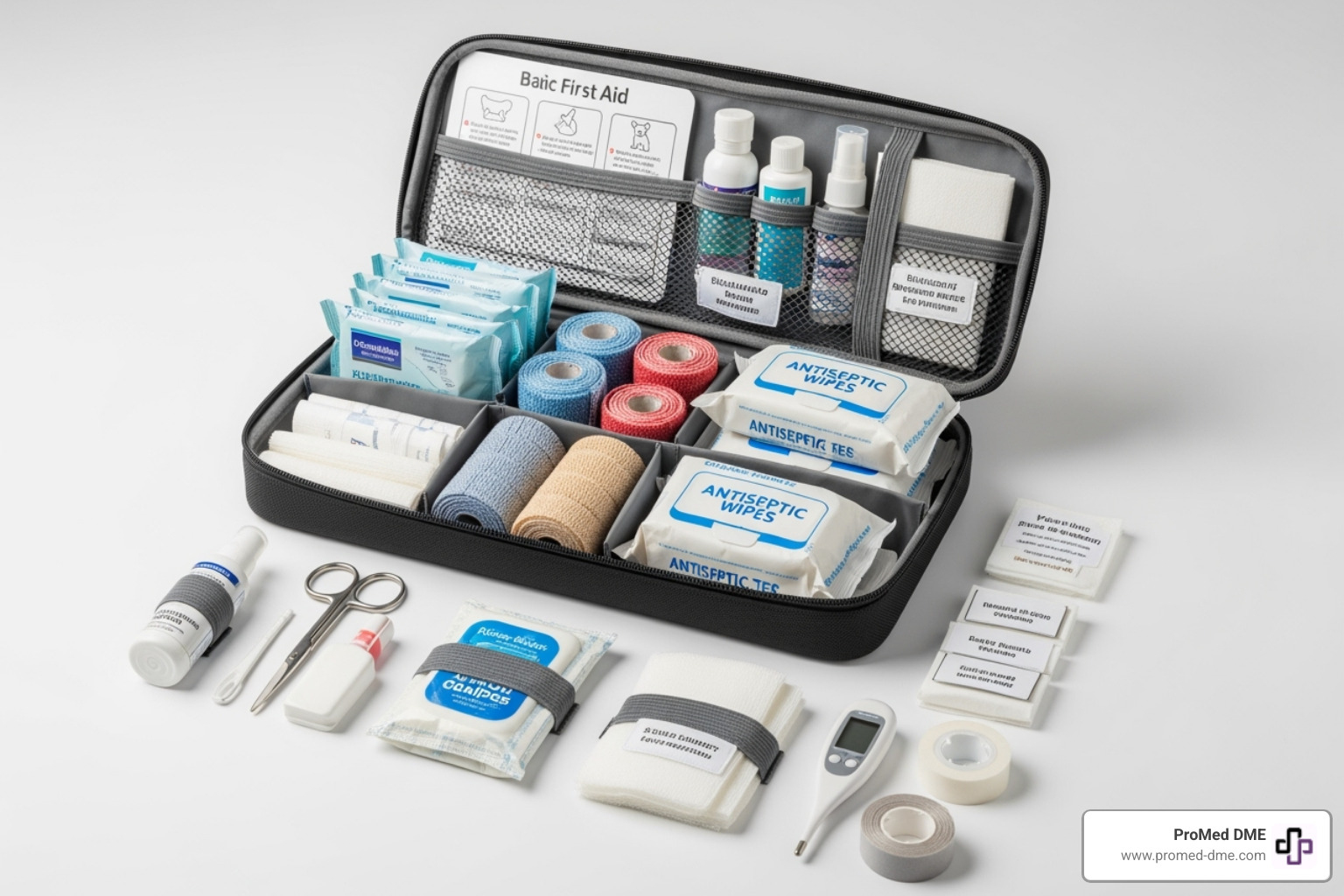
These self-adhering wraps are perfect for providing minor cuts and grazes with protective coverage, offering gentle support for sprains and strains, and securing dressings over wounds. They're also excellent for post-surgery protection when your vet sends your pup home with specific aftercare instructions, and they work wonders for discouraging licking at healing wounds—something most dogs seem determined to do!
But here's the important part: knowing when to reach for that bandage and when to reach for your phone to call the vet instead. While cohesive bandages are fantastic tools, they're not magic fixes, and some situations absolutely require professional veterinary care.
Common Injuries That Benefit from a Cohesive Bandage
Your cohesive bandage for dogs really shines when dealing with everyday injuries that need protection and support. Paw pad cuts are probably the most common scenario—these tender areas take a beating during walks and play, and a properly applied bandage keeps dirt out while the healing happens.
Minor limb sprains respond beautifully to the gentle compression these bandages provide. That slight support can make your dog much more comfortable while reducing swelling. Similarly, covering hotspots with a breathable cohesive bandage prevents your dog from making these irritated areas worse through constant licking and scratching.
Sometimes you might need to secure a splint temporarily if you suspect a fracture below the elbow or knee—though this is strictly a transport measure until you can get to your vet. And for post-operative incision protection, these bandages are invaluable for keeping surgical sites clean and undisturbed during those crucial first days of healing.
The beauty of cohesive bandages lies in their ability to provide controlled compression without cutting off circulation, making them ideal for situations where you need steady, gentle pressure. For detailed guidance on proper bandaging techniques, check out this helpful resource on Bandaging: First Aid.
Red Flags: When to Seek Immediate Veterinary Care
While we love empowering pet parents with first-aid knowledge, some situations demand immediate professional attention—no bandage required, just a quick trip to your vet.
Deep puncture wounds and suspected fractures are absolute veterinary emergencies. If your dog can't put weight on a limb or you can see bone, skip the bandage and head straight to the clinic. Uncontrolled bleeding that doesn't respond to direct pressure also needs professional intervention right away.
Once you've applied a bandage, watch carefully for warning signs that something's wrong. Swelling above or below the bandage or cold toes are serious red flags indicating the wrap might be too tight and cutting off circulation. A foul odor from the wound suggests infection is brewing, while limb disuse or increased pain could mean the injury is worse than it initially appeared.
Practical issues matter too—if the bandage becomes wet or soiled, it needs changing immediately to prevent skin problems and infection. And if your dog chews the bandage off repeatedly, they might be telling you something hurts or the bandage isn't sitting right.
The bottom line? When in doubt, make that call to your vet. Your dog's health is worth more than the cost of a professional opinion, and catching problems early almost always leads to better outcomes.
How to Safely Apply a Cohesive Bandage for Dogs
Applying a cohesive bandage for dogs might seem straightforward, but proper technique makes all the difference between helpful healing and potential harm. Think of it like wrapping a present - you want it secure but not so tight that you crush what's inside.
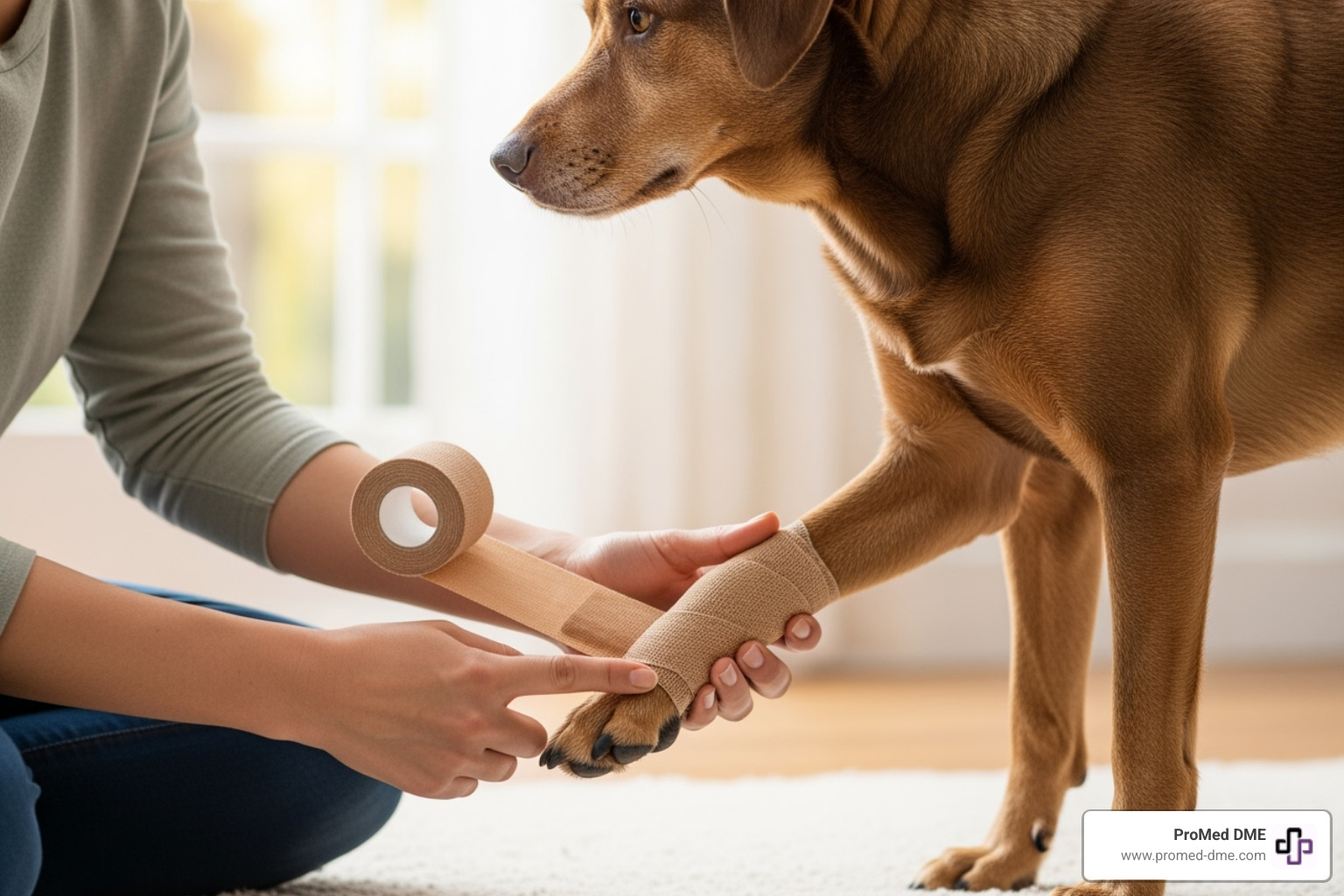
The secret to successful bandaging lies in taking your time and following a careful layering approach. We always tell pet parents to think of it as building a sandwich - each layer has its purpose, and skipping steps can lead to a messy result.
What you'll need before starting: sterile gauze pads or Telfa pads, cotton padding or Dacron wrap, a cohesive bandage for dogs, blunt-nosed scissors (though many wraps now feature EASYTEAR technology), antiseptic solution or mild soap and water, and optionally some antibiotic ointment and microporous tape.
Step 1: Prepare the Wound Area
Before you even think about wrapping, you need to be your dog's personal paramedic. This first step sets the foundation for everything that follows.
Stop any bleeding by applying gentle, direct pressure with a clean cloth for about 5 to 10 minutes. If the bleeding won't stop or seems severe, put down the bandage supplies and call your vet instead.
Once bleeding is controlled, clean the wound gently using mild soap and water or an antiseptic solution your vet recommends. Remove any dirt, debris, or dried blood - think of it as preparing a canvas for painting. You might need to carefully trim hair around the wound area to keep it from getting tangled in the bandage later.
Pat the area completely dry with a clean cloth. Moisture is the enemy of good wound healing and can turn your bandage into a breeding ground for bacteria.
Finally, apply a sterile, non-stick pad directly over the wound. Telfa pads work beautifully for this because they won't stick to the healing tissue. This protective layer prevents your bandage from becoming part of the wound itself. If your vet has recommended antibiotic ointment, apply it to this pad first.
Step 2: Apply Padding and Conforming Layers
This is where we create the cushiony foundation that makes your dog comfortable while protecting the injury.
Start with absorbent padding using cotton or Dacron wrap. This layer acts like a soft pillow, cushioning the wound and soaking up any moisture that might develop.
Here's a crucial rule: always wrap from the toes toward the body when bandaging limbs or tails. This technique prevents blood from pooling in the extremities, which could cause dangerous swelling. If you're working on a paw, place thin strips of cotton between your dog's toes to prevent uncomfortable rubbing.
Keep the pressure snug but gentle - you're not trying to compress anything yet, just providing a soft, protective layer. Each wrap should overlap the previous one by about half its width, creating a smooth, even surface without lumps or gaps.
For extra support, you can add a gauze wrap layer over the padding. This helps hold everything in place and provides a stable base for your final cohesive layer.
Step 3: Apply the Cohesive Bandage for Dogs
Now comes the star of the show - your cohesive bandage for dogs. This self-sticking wonder will hold everything together without grabbing onto fur or skin.
Stretch the bandage gently before you start wrapping. This "pre-stretching" helps you understand how much tension you're applying and prevents accidentally creating a tourniquet around your dog's limb.
Apply with steady, even pressure, continuing that toes-to-body direction. Each layer should overlap the previous one by half, creating a secure hold without pressure points. The key is finding that sweet spot between "too loose and falls off" and "too tight and cuts off circulation."
Never stretch the bandage to its limit - this is the most important rule. Over-stretching can turn your helpful bandage into a dangerous tourniquet that cuts off blood flow.
Cover all the padding completely and extend slightly beyond it at both ends. This prevents the inner layers from shifting or bunching up under the cohesive wrap.
Secure the end by pressing it firmly against the previous layer. The beauty of cohesive bandages is that they stick to themselves without needing clips, pins, or tape.
Do the two-finger test immediately after finishing. You should be able to slide two fingers comfortably under the top edge of the bandage. If you can't, it's too tight and needs to be rewrapped. Also check your dog's toes for any swelling or coldness - these are warning signs of restricted circulation.
For additional guidance and visual demonstrations, check out How to Apply a Bandage to Your Dog. Practice makes perfect, but your dog's comfort and safety always come first.
Choosing the Best Cohesive Bandage for Your Dog
Not every cohesive bandage for dogs is made the same way, and choosing the right one can make all the difference in your pup's comfort and healing. Think of it like shopping for a good pair of running shoes – you want something that fits well, performs its job, and doesn't cause problems down the road.
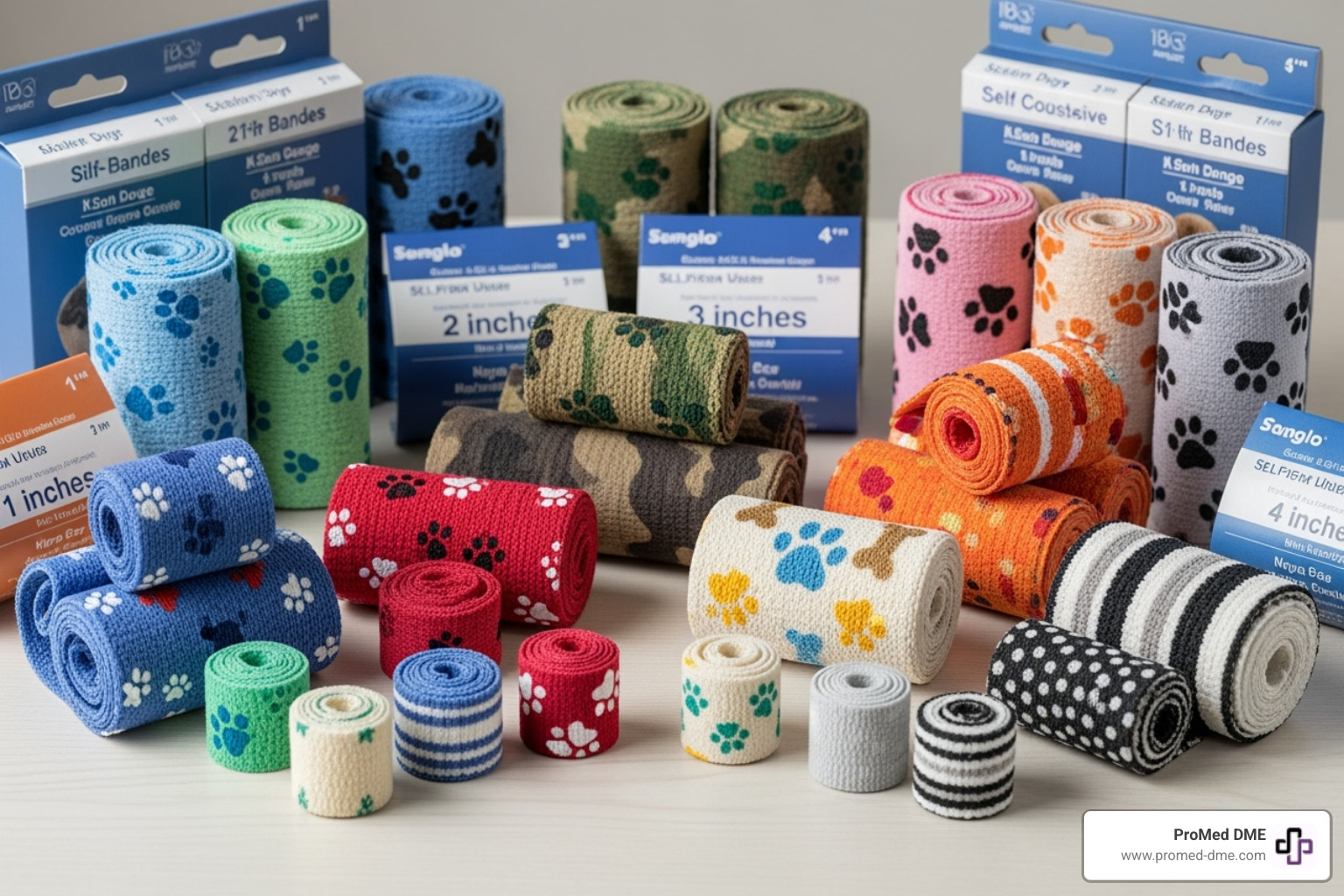
At ProMed DME, we've seen what works and what doesn't when it comes to pet care supplies. The best cohesive bandages share several important qualities that make them stand out from the rest. They need to be porous and breathable to let air reach the wound, light and soft so your dog stays comfortable, and most importantly, they must stick to themselves without grabbing onto fur or skin.
The beauty of a quality cohesive bandage lies in its simplicity. No clips, no pins, no wrestling with adhesive tape that pulls at your dog's fur. Just a smooth, secure wrap that does its job and comes off easily when it's time for a change.
Key Features of a Quality Cohesive Bandage for Dogs
When you're picking out a cohesive bandage for dogs, there are several features that separate the good ones from the great ones. Self-adhering properties top the list – this means the bandage sticks firmly to itself while staying gentle on your dog's skin and fur. You'll know you have a good one when removal doesn't turn into a tug-of-war with your pet's coat.
Breathable, porous fabric makes a huge difference in healing. High-quality non-woven fabric allows air to flow through, preventing that stuffy, moist environment where bacteria love to grow. Your dog will be more comfortable, and wounds heal better when they can breathe.
Look for water-resistant options that can handle a little moisture from activity or light rain. While they're not meant for swimming, these bandages stay put even when your active pup works up a sweat during recovery.
Some premium bandages feature EASYTEAR technology, which is incredibly handy during stressful moments. Instead of fumbling around for scissors while your dog squirms, you can simply tear the bandage cleanly by hand. It's one of those features you don't think about until you really need it.
Controlled compression is where the science really matters. Different bandages offer different levels of support – some provide 10 pounds of tensile strength for light support, others go up to 15 pounds for general use, and heavy-duty options deliver 23 pounds for maximum stability. The key is choosing the right strength for your dog's specific needs without overdoing it.
For dogs with sensitive skin, hypoallergenic and latex-free options are available. These bandages avoid common irritants while still delivering the same reliable performance. They're also free from harmful solvents, giving you peace of mind about what's touching your pet's skin.
Size and width matter more than you might think. A 1-inch bandage works perfectly for small paws or tails, while 2-inch or 3-inch options handle legs and larger areas. 4-inch bandages are great for bigger dogs or when you need to cover more ground. Getting the right size makes application easier and more effective.
Special Types: Bitter and No-Chew Bandages
Let's be honest – some dogs are determined to undo all your careful bandaging work. If you've ever watched your pup methodically chew off a bandage you just applied, you know exactly what we're talking about. That's where bitter and no-chew bandages become absolute lifesavers.
These specialized cohesive bandages for dogs come infused with a bittering agent that tastes terrible but won't harm your pet. The non-toxic deterrent creates an unpleasant experience that most dogs quickly learn to avoid. It's like having a built-in "no thank you" message that protects the bandage and keeps the wound healing properly.
Deters chewing and licking without requiring you to hover over your dog constantly. The bitter taste is strong enough to discourage even persistent dogs who usually see bandages as interesting new chew toys. This wound protection feature can be the difference between successful healing and repeated trips to apply fresh bandages.
These bitter bandages are ideal for persistent dogs who just can't leave well enough alone. If your pup has a history of removing bandages or you're dealing with a wound in a tempting location, investing in a no-chew variety saves time, reduces stress, and promotes better healing outcomes for everyone involved.
Frequently Asked Questions about Cohesive Bandages
As pet parents, we know how many questions can pop up when you're caring for an injured pup. At ProMed DME, we've heard just about every concern imaginable about using a cohesive bandage for dogs. Let's tackle the most common ones together.
Can I reuse a cohesive bandage on my dog?
Here's where we need to think about what we're treating. The answer isn't a simple yes or no—it depends entirely on whether you're dealing with a wound or just providing support.
For wound care, we always recommend using a fresh bandage every time. Once a cohesive bandage for dogs has been in contact with an open wound, it's no longer sterile. Reusing it could introduce harmful bacteria right back into the healing tissue, potentially causing infection and setting back your dog's recovery. When it comes to wounds, sterility isn't negotiable.
But here's the good news: for support applications, like helping with a chronic joint issue or providing stability for a sprain without any open skin, these bandages can often be reused. Cohesive bandages are designed to maintain their self-adhering properties even after removal. You can take them off, store them properly, and reapply them when needed—making them much more economical than traditional adhesive tapes for ongoing support needs.
Just keep in mind that with each use, the compression may decrease slightly, and the bandage might not stick quite as firmly as when it was brand new. Always make sure the bandage is completely clean and dry before putting it back on your dog. When in doubt? Grab a fresh one.
How tight should a cohesive bandage be?
This question keeps us up at night—and for good reason. Getting the tension just right is absolutely critical for your dog's safety and comfort. Too tight, and you could cut off circulation. Too loose, and the bandage won't do its job.
We swear by the "two-finger rule"—and we mean it literally. After you've applied the bandage, slide two of your fingers under the top edge. They should fit comfortably between the bandage and your dog's skin without forcing them in. If you can't get your fingers underneath, or if it feels like you're squeezing them in, the bandage is too tight and needs to come off immediately.
Too tight can be dangerous. We're talking about potential nerve damage, tissue death, or even limb loss in severe cases. Watch for warning signs like swelling above or below the bandage, cold toes if you've bandaged a leg, or your dog becoming increasingly agitated and trying to remove the bandage.
On the flip side, too loose won't help anyone. A loose bandage will slip, bunch up, and likely end up as an expensive chew toy on your living room floor instead of protecting your pup's injury.
Think of it like a firm handshake—confident and secure, but never painful or restricting.
How long can my dog wear a cohesive bandage?
The honest answer is: it depends on what you're treating, and your vet should always have the final say on timing. But we can give you some general guidelines to help you plan.
For open wounds, we typically recommend changing the cohesive bandage for dogs daily. This allows you to clean the wound, check for signs of healing or infection, and apply fresh medication if needed. If the bandage gets wet, dirty, or starts to smell, it needs to come off immediately—don't wait for the 24-hour mark.
For support applications without open wounds, your vet might give you the green light to leave the bandage on for 24 to 48 hours. But this comes with a big caveat: you need to check on things regularly.
Monitor constantly for swelling, unusual odors, or signs that your dog is uncomfortable. Dogs are pretty good at telling us when something's wrong—they'll lick, chew, limp more than usual, or seem generally unhappy with their situation.
Keep it clean and dry at all costs. A wet bandage is like a bacteria playground, and nobody wants that. If you're bandaging a paw and your dog needs to go outside, consider slipping a plastic bag over the bandage for protection. Just remember to remove it as soon as you come back inside.
Here's our golden rule: never leave any bandage on for more than 24 hours without at least checking underneath, unless your vet has specifically told you otherwise for medical reasons. Your dog's comfort and safety are worth the few extra minutes it takes to peek under that wrap and make sure everything looks good.
Keep Your Pup Prepared and Protected
As devoted pet parents, we know that life with our four-legged family members can be wonderfully unpredictable. One moment they're peacefully napping in a sunbeam, and the next they're chasing a squirrel through brambles or getting a little too enthusiastic during playtime. That's why having a well-stocked first-aid kit, complete with a high-quality cohesive bandage for dogs, gives us the confidence to handle those inevitable bumps and scrapes.
Throughout this guide, we've finded how these remarkable self-adhering wraps revolutionize pet first aid. Unlike traditional bandages that can turn bandage removal into a traumatic tug-of-war with your dog's fur, cohesive bandages stick only to themselves. This means pain-free removal and controlled compression that actually helps rather than hinders the healing process.
We've explored their incredible versatility—from protecting minor cuts and supporting sprains to securing post-operative dressings and even deterring that persistent licking habit so many of our pups seem to have mastered. The step-by-step application process we've covered empowers you to provide immediate, effective care when your furry friend needs it most.
Remember the key features we discussed: breathable materials that promote healing, EASYTEAR® technology for easy application, and those clever bittering agents for dogs who think bandages are just another chew toy. Whether you need the gentle 10 lb tensile strength of COFLEX® for light support or the robust 23 lb strength of POWERFLEX® for maximum stability, there's a solution for every situation.
Most importantly, we've learned to recognize our limits. While cohesive bandages for dogs are fantastic tools, they're part of a larger picture of responsible pet care. Those red flags we discussed—uncontrolled bleeding, suspected fractures, signs of infection—these are clear signals that it's time to let the professionals take over.
At ProMed DME, we understand that caring for our beloved pets is just as important as caring for ourselves. Our commitment to delivering top-quality medical supplies extends to helping you build that essential first-aid kit. With our free shipping, dedicated nurse on staff, and exceptional customer service, we're here to support you in keeping your furry family healthy and happy.
The peace of mind that comes from being prepared is invaluable. When your adventurous pup inevitably finds their next scrape or strain, you'll be ready with the right supplies and knowledge to help them bounce back to their tail-wagging selves.
When in doubt, consult a veterinarian.
Recursos y artículos relacionados
Manténgase informado con las entradas de nuestro blog informativo.
Descubra las ventajas de ProMed
y pruebe nuestros productos
Ofrecemos envío gratuito y un legendario servicio de atención al cliente para garantizar que reciba los
mejores productos de DME para sus necesidades.

